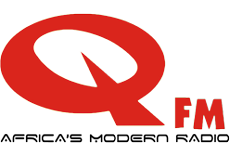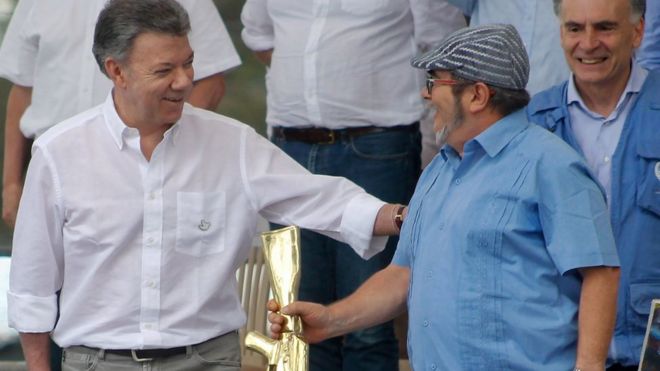Colombia’s Farc rebel group has formally ended its existence as an armed group, putting an end to half a century of violent conflict.
In a ceremony which ended the disarmament process, President Juan Manuel Santos said the “peace was real and irreversible”.
The former guerrillas will now work on forming a political party.
“Farewell to war. Farewell to arms, welcome to peace!” said Farc leader Rodrigo Londoño, known as Timochenko.
President Santos is now trying to strike a similar deal with the National Liberation Army (ELN), Colombia’s second-largest left-wing rebel group.
The handover of 7,132 weapons was a key demand in the peace process signed last year, which marked the end of the Farc’s 52-year conflict in which 260,000 people were killed.
- Farc rebels to train as bodyguards
- Colombian Farc embarks on ‘final march’
- A rare look inside a Farc rebel camp
In the event in Mesetas, a small central town in an area that was once the group’s stronghold, Timochenko said the Farc would continue to exist, but in a different legal and democratic form as it enters a new phase in its history.
They are expected to change their name, as the long-standing acronym stands for Revolutionary Armed Forces of Colombia.
“Today, we are not letting Colombia down. Today, we are laying down our weapons,” he said.
President Santos, who won a Nobel Prize for his efforts in securing the agreement, hailed it as a “very special day” and “the day weapons became words.”
The fact that more than 9,000 Farc fighters and militiamen are not armed any more represents a crucial landmark in the implementation of the peace process between the government and the group.
President Santos said this was the best news for Colombia in 50 years. He gave an AK-47 rifle that an artist had transformed into a shovel as a present to Timochenko to “cultivate peace”.
When Timochenko spoke, he said that the Farc had not failed Colombia, because they had handed over their weapons.
After his speech, hundreds of small white butterflies were released. Hundreds of Farc members and dozens of government officials were watching the ceremony here. Most of the rebels and officials were wearing white shirts and t-shirts, a symbol of peace.
United Nations monitors in the country said on Monday that the arms handover had been completed a day ahead of a revised schedule. The weapons have been registered and boxed away, they added.
Speaking at the ceremony, Jean Arnault, the head of the UN’s mission in Colombia, said the disarmament process was an example to the rest of the world.
The monitors said they had also found and emptied 77 out of the Farc’s 900 arms caches hidden around the countryside.
However, US monitors have warned that the task of locating and emptying the Farc’s remaining caches could take many months because of the difficulty in reaching them.
Some of them are reachable only by river or foot through dense jungle and mountain terrain. Many are booby-trapped and need to be painstakingly dismantled.
Many Colombians are concerned that if there is any delay, these weapons could fall into the hand of criminals, paramilitaries or the ELN.
There are also worries over the fate of territory and drug-trafficking operations that were previously controlled by the Farc.
Two Dutch journalists were abducted, then released a week later, by the ELN this month.
At the weekend, nine members of the self-styled People’s Revolutionary Movement (MRP) were arrested in connection with the bombing of a shopping mall in Bogotá, also in June.
BBC
 Q FM Africa's Modern Radio
Q FM Africa's Modern Radio
